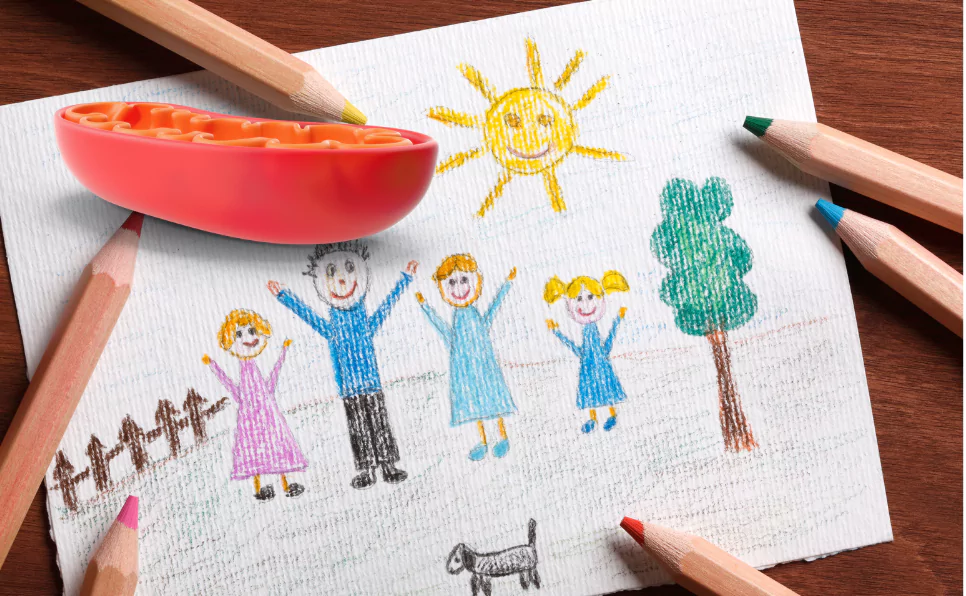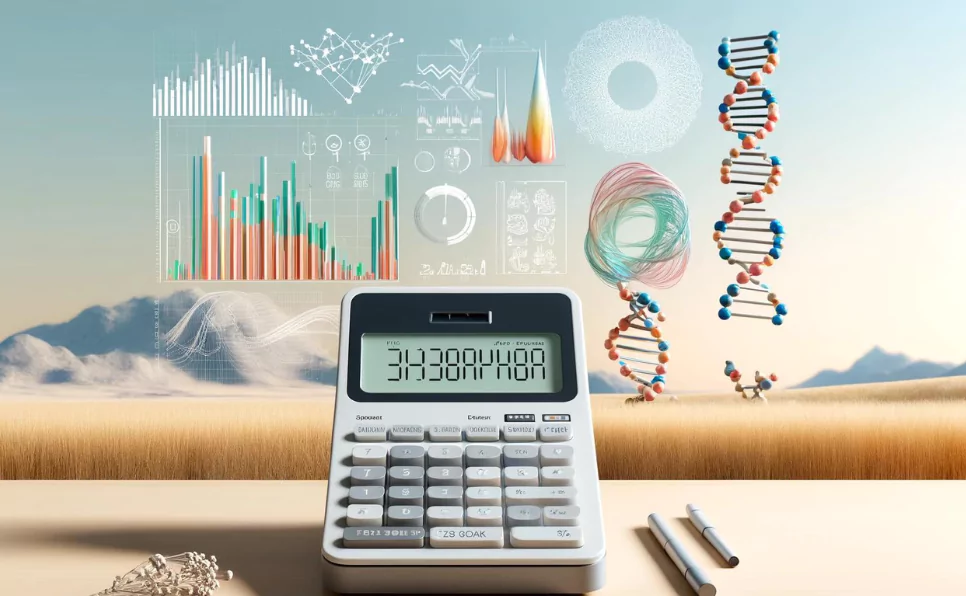We all know we have DNA in our bodies, which is basically the blueprint for making us who we are. But not all DNA is the same, it comes in two main types: the kind you’ve probably heard a lot about, which lives in the nucleus of our cells, and then there’s mitochondrial DNA (mtDNA), which is a bit different and has a unique way of being passed down through generations.
What’s fascinating is that though both are made of the same 4 letters and code for proteins they are vastly different in where they live, how they are organized, and more importantly how they are passed on from one generation to another.
You might have also heard somewhere that we all inherit our mother’s DNA. In this article we will get into the nitty gritty of this inheritance pattern and how it matters.
Two Types of DNA
The DNA in the nucleus of our cells is like the main library of our genetic information.
It’s got all the instructions needed to make and maintain a human being.
Mitochondrial DNA, on the other hand, is like a special collection within the library, focused solely on energy production. It’s smaller, yes, but super important because it helps our cells make energy.
The Inheritance of Mitochondrial DNA
Maternal Inheritance
When we talk about inheritance, we’re usually picturing the mix-and-match game of nuclear DNA, half from mom, half from dad, right?
Well, its not how mitochondrial DNA is inherited. mtDNA doesn’t play by those rules. It’s passed down a different path, one that’s all about the moms.
Here’s why:
Imagine the moment of conception as a tiny dance floor where the egg and sperm meet up.
The egg is like a huge ballroom, spacious with lots of stuff inside, including these tiny power generators called mitochondria.
The sperm, on the other hand, is more like a determined dancer who’s there to deliver DNA to the egg.
Now, even though the sperm has a few mitochondria too, they’re basically left at the door when the DNA enters the egg.
Why does this happen? Well, the egg’s cytoplasm, which is the gel-like substance filling the egg, is where the mitochondria live.
And since only the egg provides this cytoplasm to the future embryo, the mitochondria (and thus the mtDNA) come exclusively from the egg.
That means the mtDNA you have is almost a carbon copy of your mom’s mtDNA, making it a maternal legacy passed down through generations.
Exceptions to the Rule
Now, nature loves to keep us on our toes, and while the rule of maternal inheritance of mtDNA is pretty solid, there are those rare exceptions that remind us biology doesn’t always stick to the script.
Recent studies have turned up some fascinating cases where mtDNA from the father does make it into the offspring, challenging the long-held belief that mtDNA could only come from the mother.
These instances are incredibly rare, but they’re important because they show that the mechanisms of inheritance can be more flexible than previously thought.
In these rare cases, it seems that some of the father’s mitochondria manage to sneak past the usual barriers and blend into the egg’s cytoplasm, making it through to the embryo.
Scientists are still figuring out how and why this happens.
Is it a fluke? Or could it be a previously overlooked pathway of inheritance?
This discovery has opened up new areas of research, pushing scientists to reconsider some of the fundamental concepts of genetic inheritance.
It’s important to note that while the possibility of paternal mtDNA transmission exists, it’s not something that happens in the majority of cases.
The overwhelming majority of people will find their mtDNA is a gift from their mothers, tracing back through generations of maternal ancestors.
Mitochondrial DNA and Genetic Disorders
Because mtDNA is all about energy production, mutations in it can lead to issues with how our cells make energy.
This can result in mitochondrial diseases, which can affect almost any part of the body and can be pretty serious.
These diseases are directly tied to problems in the mtDNA and can range from muscle weakness to more severe conditions affecting the brain, heart, and other organs.
Identifying Mitochondrial Disorders
Diagnosing these conditions can be tricky. It often involves looking at a person’s symptoms and may include genetic testing to spot mutations in the mtDNA. There’s a lot of ongoing research here, trying to make diagnosis easier and more accurate.
Implications of Mitochondrial DNA Inheritance
Understanding how mtDNA is passed down has opened up new paths for treating and even preventing mitochondrial diseases.
There’s talk about mitochondrial replacement therapy (MRT), which is a bit controversial but has the potential to prevent diseases from being passed on from mother to child.
MRT is a big deal because it represents a potential way to stop mitochondrial diseases from being passed down from one generation to the next.
It’s like you can take an egg and replace the “faulty” mitochondria with healthy ones from a donor egg. This means the future child would have the nuclear DNA from their parents but the mtDNA from a donor (thus a total of three parents).
This mix could theoretically eliminate the risk of passing on mitochondrial diseases. It’s like renovating a house to replace a faulty power system with a new, fully functional one, ensuring everything inside runs smoothly.
Though many ethical questions still remain and are being addressed it provides hope for families that face these incurable conditions.
FAQs
Can both parents pass on mitochondrial DNA to their children?
Typically, no. It’s almost always just from the mom. But, science has shown us there are rare exceptions.
Why is mitochondrial DNA only inherited from the mother?
It’s because of how eggs and sperm are made and combine. The egg’s cytoplasm, which includes mitochondria, merges with the sperm’s DNA, but not its mitochondria.
How can mitochondrial DNA mutations affect health?
Mutations can mess with how cells make energy, leading to a range of health issues, from muscle weakness to more severe conditions affecting major organs.
Can mitochondrial DNA be used in genealogical testing?
Yes, it can. Since mtDNA is passed down from mothers to their children relatively unchanged, it’s a useful tool for tracing maternal ancestry.
What are the treatment options for mitochondrial disorders?
Treatment varies widely depending on the condition but can include vitamins, supplements, and other therapies aimed at managing symptoms. There’s also research into more advanced options like gene therapy.
Final Thoughts
mtDNA might be just a small part of our genetic makeup, but it plays a huge role in our health and how we understand genetic inheritance.
The way it’s passed down from mothers to their children is not just a fascinating piece of the puzzle of life; it’s also key to unlocking new ways to treat and prevent genetic disorders related to mtDNA.
As research continues, we’re likely to see even more advancements in this field, offering hope to those affected by mitochondrial diseases.
For Further Reading:
- Paternal comeback in mitochondrial DNA inheritance. PNAS
- Inheritance of mitochondrial DNA in humans: implications for rare and common diseases. J. Intern Med
- Molecular basis for maternal inheritance of human mitochondrial DNA. Nature Genetics
- Biparental inheritance of mitochondrial DNA revisited. Nature
- mtDNA and Mitochondrial Diseases. Learn Science at Scitable by Nature Education

Dr. Sumeet is a seasoned geneticist turned wellness educator and successful financial blogger. GenesWellness.com, leverages his rich academic background and passion for sharing knowledge online to demystify the role of genetics in wellness. His work is globally published and he is quoted on top health platforms like Medical News Today, Healthline, MDLinx, Verywell Mind, NCOA, and more. Using his unique mix of genetics expertise and digital fluency, Dr. Sumeet inspires readers toward healthier, more informed lifestyles.





